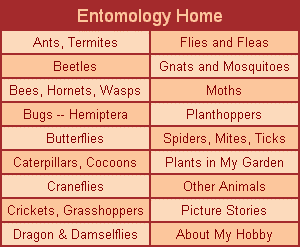| Period |
ID'd |
unID'd |
Total |
| Thru Nov. 7,
2003 |
61
|
27
|
88
|
| Thru April
2004 |
110
|
20
|
130
|
| May 2004 |
224
|
12
|
236
|
| June 2004 |
76
|
31
|
107
|
| July 2004 |
65
|
31
|
96
|
| August
2004 |
48
|
17
|
65
|
| September
2004 |
17
|
20
|
37
|
| October
2004 |
6
|
6
|
12
|
| 2004 Ending Total |
607
|
164
|
771
|
| 2006 Ending Total |
719
|
100 ? |
819 ? |

At the end of the 2003 moth
season (Oct. 8 to Nov. 7), with a few days off for bad weather, I
photographed 85 species of moths in my yard. The great majority of them
were attracted to the coach lamp at my side door, or to the pair of lamps
mounted on the front of my house. Each lamp contained a regular 100-watt
light bulb. I used no baits or special lights. I am absolutely certain
that I missed at least 15 species simply because I did not spend 100% of
my time outside. I saw a few species that flew away before I could get a
photograph. There were times I had to make a choice as to which new
species to shoot first, and my activities provoked others into leaving
before I could get around to them. I suspect that in 2004, with a full
season that is 7-8 times longer than my limited 2003 season, I might
easily surpass 400 species of moths, and possibly 500. [How about 800??]
It will be fun finding out. I got a few other species of moths earlier in
the year when I was collecting butterflies. So, I'm going to start the
scorecard at 88 species. [Note, 12/26/04] Of the 771 species noted at
right, 2 species came from Larry Line's place in Clarksville, MD., and
have not yet been seen in my yard.
June 1, 2004: I
now use a high intensity mercury vapor lamp as well as a fluorescent black
light to attract moths to resting areas in my yard. Nearly all the
photography is done indoors in the new Moth Lounge that I built in a
corner of my large storage room. To calm the moths captured in
prescription medicine vials they are placed in the Moth Fridge for about
two hours. Then they are released onto an appropriately colored background
surface where, if they remain still, I take several photographs. They are
also free to fly about the small moth lounge (a fair percentage do so)
where I wait for them to land on the carpet or a wall. Sometimes they
prefer to land on me and I have to turn the camera on myself to photograph
them on my shirt, pants or shoes. After I take their photographs the moths
are released to the outdoors, excepting the case of new species that I
give to Larry Line (in which case he photographs and releases them). A few
moths die from this handling, but the percentage is very small.
December 26, 2004: Although the table above shows
607 identified species I can find only 601 possibly distinct species in
the folders for which I have pages now on this website. I expect that,
when I have time to combine all my unidentified moths onto one series of
pages, with duplications deleted, that the 164 species listed above will
shrink to something like 130 or so. Thus, my total for the year may
actually be about 735 species. The last seven new species for the year
were attracted, during the period October 26 through November 4, to bait
painted on boards and trees in my yard, and on a few trees and a powerline
pole just across the street. For the most part my various lights stopped
attracting moths after about October 15, which was very different from
2003. Our days and evenings in late October and early November 2004 were
generally cooler than during the same period of 2003.
What
About YOUR Yard?: One of the purposes of my websites is to
encourage others to take up the hobby of nature photography, right in
their yard and garden. Prior to this past year (but after 50 years as a
nature enthusiast) I had absolutely no idea of the hundreds of species of
moths that share "my space." Or of the many hundreds of other insect
species that abound on my small property, in the aggregate probably
exceeding the number of species of moths. A digital camera is all that is
needed to begin an inexpensive hobby. Identifying what you photograph and
sharing the photos with others via the Internet can be a very rewarding,
intellectual experience. Becoming more aware of YOUR place in nature can
be exciting!
Apart from the intensive effort that I put forth this
year in photographing moths, my record of 700+ species in one year is
probably nothing special, and could be duplicated with equal or less
effort elsewhere. Almost everyone lives amidst an abundance of moths.
David Beadle tells me that he has photographed in just a few years about
300 species of moths in his tiny yard (15 ft. x 15 ft.) in urban Toronto,
Canada. Lynn Scott, near Ottawa but in the suburbs, has recorded over 400
species in a few years. Larry Line, 20 miles from me here in Maryland (but
in a slightly more upland area), has photographed about 600 species at his
place. In a suburban Connecticut location John Himmelman has identified
about 700 species of macromoths on his property over a period of years
(and has probably ignored almost as many micromoths). David Wagner, also
in Connecticut, has had about 200 species attracted in one night by light
to a sheet at a favorable location, and he tells me that almost any
location will yield 1,200 species of moths (including micros) over time.
Bruce Walsh tells me that in southeastern Arizona 1,000 species of
macromoths ought to be a possibility almost anywhere.
Acknowledgments: I owe a large debt of gratitude to
Larry Line for his extensive support (encouragement, help with moth
identification, loan of literature), advice and companionship. I can
rather easily find about 70% of all the macromoths that I photograph
already on Larry's website. The micromoths are a different matter.
Photographs (mainly micros) have been sent to John Glaser who provides
tremendous assistance with the identification of species we cannot find in
our literature collection or on the Internet. John has a significant
collection of Maryland moths, and he frequently supplies us with photos
from his collection to gently explain to us why something often isn't what
we think it is.
Numerous other persons have been a great help,
either through email exchanges or by posting their own photographs on
websites where we can search for species not found in the Covell Field
Guide or other literature. Tony Thomas, of New Brunswick, Canada, has been
invaluable to me. Hugh McGuinness and Steve Walter of New York, James
Adams of Georgia, Lynn Scott of Ottawa, Canada, Cindy Mead of Michigan,
Leisa Royse of Kentucky, Jerry Fauske of North Dakota, and Dean Edwards of
Tennessee each have a large share of my gratitude
|

